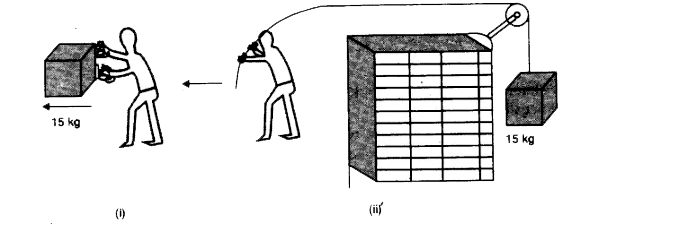An artificial satellite orbiting the earth in a very thin atmosphere loses its energy gradually due to dissipation against atmosphere resistance, however small. Why then does its speed increase progressively as it comes closer and closer to the earth?
As the satellite comes closer to earth its P.E. decreases and K.E. increases. The increase in K.E. is greater than the rate of dissipation of heat. Hence speed increases.
Topper's Solved these Questions
- DYNAMICSBOOK - ICSECHAPTER - DYNAMICSEXERCISE - SHORT ANSWER QUESTIONS WITH ANSWERS
12 Videos
- DYNAMICSBOOK - ICSECHAPTER - DYNAMICSEXERCISE - SELECTED PROBLEMS
249 Videos
- DIMENSIONSBOOK - ICSECHAPTER - DIMENSIONSEXERCISE - SELECTED PROBLEMS (FROM CONVERSIONS OF ONE SYSTEMS OF UNITS INTO ANOTHER)
9 Videos
- FRICTIONBOOK - ICSECHAPTER - FRICTIONEXERCISE - Selected problems
30 Videos
Similar Questions
Answer the following:
a) The casing of a rocket in flight burns up due to friction. At whose expense is the heat required for burning obtained? The rocket or the atmosphere?
b) Comets move around the sun in highly elliptical orbits. The gravitational force on the comet due to the sun is not normal to the comet's velocity in general. Yet the work done by the gravitatonal force over every complete orbit of the comet is zero. Why?
c) An artificial satellite orbiting the earth in very atmosphere loses its energy grdually due to dissipation against atmospheric resistance, howerver small. Why then does its speed increase progressively as it comes closer and closer tothe earth? d)In fig i) the man walks 2m carrying a mass of 15 kg on his hands. In Fig ii) he walks the same distance pulling the rope behind him. The rope goes over pulley, and a mass of 15 kg hangs at its other end. In which case is the work done greater?

View SolutionAnswer the following:
a) The casing of a rocket in flight burns up due to friction. At whose expense is the heat required for burning obtained? The rocket or the atmosphere?
b) Comets move around the sun in highly elliptical orbits. The gravitational force on the comet due to the sun is not normal to the comet's velocity in general. Yet the work done by the gravitatonal force over every complete orbit of the comet is zero. Why?
c) An artificial satellite orbiting the earth in very atmosphere loses its energy grdually due to dissipation against atmospheric resistance, howerver small. Why then does its speed increase progressively as it comes closer and closer tothe earth? d)In fig i) the man walks 2m carrying a mass of 15 kg on his hands. In Fig ii) he walks the same distance pulling the rope behind him. The rope goes over pulley, and a mass of 15 kg hangs at its other end. In which case is the work done greater?

View Solution
Knowledge Check
A satellite going round the earth in a circular orbit loses some energy due to a collision. Its speed is υ and distance from the earth is d.
Ad will increase, υ will increaseBd will increase, υ will decreaseCd will decrease, υ will decreaseDd will decrease, υ will increase.When a satellite going around the earth in a circular orbit of radius r and speed v loses some of its energy, then
Ar and v both increasesBr and v both decreasesCr will increases and v will decreasesDr will decreases and v will increasesWhen a satellite in a circular orbit around the earth enters the atmospheric region, it encounters small air resistance to its motion. Then
Aits kinetic energy increasesBits kinetic energy decreasesCits angular momentum about the earth decreasesDits period of revolution around the earth increases
An artificial satellite orbiting the earth in very thin atmosphere loses its energy gradually due to small but continuous dissipation against atmospheric resistance. Then explain why its speed increases progressively as it comes closer and closer to the earth.
View SolutionAn artificial satellite orbiting the earth in very thin atmosphere loses its energy gradually due to small but continuous dissipation against atmospheric resistance. Then explain why its speed increases progressively as it comes closer and closer to the earth.
View SolutionWhen a satellite in a circular orbit around the earth enters the atmospheric region, it encounters small air resistance to its motion. Then
View SolutionWhen a satellite in a circular orbit around the earth enters the atmospheric region, it encounters small air resistance to its motion. Then
View SolutionAn artificial satellite of Earth nears the end of its life due to air resistance. While still in orbit:
View Solution
